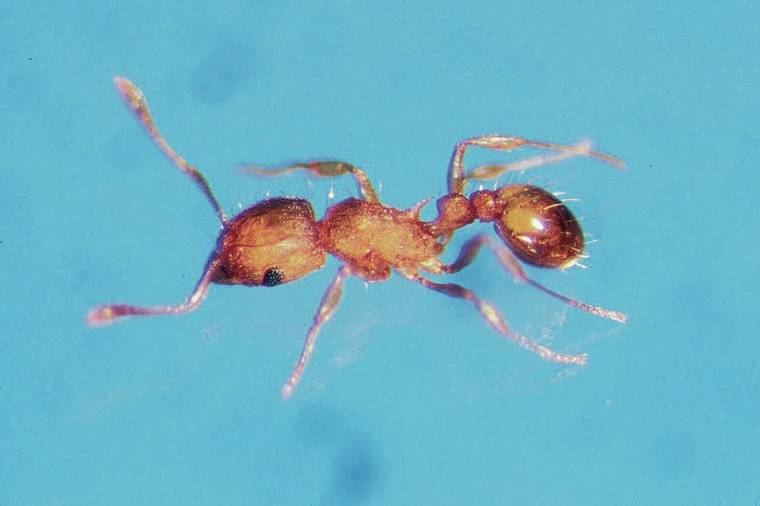Legislation tackles fire ant problem

Rob Curtiss hold a vial of dead little fire ants. (Craig T. Kojima/Hawaii Tribune-Herald)

Little Fire Ants, originally from South America, are considered among the world’s worst invasive species. LFA are tiny ants, measuring 1/16th inch long, are pale orange in color and move slowly. (Courtesy photos/Hawaii Dept. of Agriculture)
Whats the best way to eradicate little fire ants?
What’s the best way to eradicate little fire ants?
Two bills introduced by Big Island legislators would require the state Department of Agriculture to identify best practices for treatment of the invasive pests.
House Bill 1854, introduced by state Rep. Nicole Lowen of Kailua-Kona, and Senate Bill 2474, introduced by state Sen. Russell Ruderman of Puna, are working through their respective chambers.
The bills would require the DOA to work with the Hawaii Ant Lab to identify and post on the department website the best ways to control the insects.
The House bill would require pest control operators to use those guidelines.
Similarly, the Senate bill would allow the state Pest Control Board to revoke, suspend or refuse to renew any licenses of those who don’t follow those practices.
Lowen, chairwoman of the House Committee on Energy and Environmental Protection, said there have been reports that in some instances, not all pest control operators are informing customers about the best treatment options or educating customers about those choices.
There never have been requirements for pest control operators when that work intersects with something identified as an invasive species, she said.
The Senate Committee on Agriculture and Environment, of which Ruderman is vice chairman, held a public hearing on the measure Feb. 7.
While there was some support for the Senate bill, there also was significant opposition, according to written testimony submitted before the Senate hearing.
In submitted testimony, Brian Miyamoto, executive director of the Hawaii Farm Bureau, said that agriculture is “one of the major casualties” of invasive species.
“HFB recognizes the harm that the little fire ant has caused to farms, businesses, and the quality of life of those affected by this pest,” he wrote. “We agree that continued measures must be undertaken to stop its spread to other areas.”
Tim Lyons, executive director of the Hawaii Pest Control Association, said the organization opposes the bill.
“Our opposition lies not in its intent because we, after all, do recognize the problem of the little fire ants and the horrible situation that our Big Island residents are in as they have to cope with the pest,” Lyons wrote. “We also are, of course, not opposed to any efforts and any advice or information from the Hawaii Ant Lab. Our opposition is that the Hawaii Ant Lab is not the ‘be all to end all.’ It is not the only expert and authority on controlling ants.”
The pest control industry will find what best practices are long before the DOA and the Pest Control Board will know about and develop rules to implement them, he said.
The Pest Control Board also opposed the legislation.
While the board “appreciates the bill’s intent to help mitigate the harmful effects and active spreading of an invasive species,” Executive Officer Lei Ana Green said the cost of the additional regulations would be passed onto customers by mandating that a sole entity approve best practices, and that those practices should not be included in statutes and rules.
“The industry is dynamic and dictates best practices, as not only do the pesticides, technologies and methodologies change, but the insects themselves change and evolve,” Green wrote. “An effective method for mitigating an invasive species may exist, but regulating methodology with statutes and rules will make it challenging for the industry to quickly adapt with more effective solutions that may arise through current and future research and application.”
Phyllis Shimabukuro-Geiser, chairwoman of the state Board of Agriculture, said the DOA also opposes the measure.
The House bill is scheduled to be heard by the Energy and Environmental Protection committee at 8:30 a.m. today.
“Certainly, some concerns (have) come up in testimony that are fair and have to be addressed,” Lowen said, adding that these conversations are important “because little fire ants are no joke.”
According to the Hawaii Invasive Species Council website, infestations are widespread throughout the windward side of the Big Island, including Hilo, Puna and along the Hamakua Coast, but smaller infestations have been found in the Kailua-Kona area.
They were first discovered on the Big Island in 1999, Maui in 2009 and Oahu in 2013. One infestation is known on Kauai.
The pests can deliver painful stings and can infest agricultural fields and farms, where they damage crops and sting workers, the Invasive Species Council said.
Ants can also infest houses, beds, furniture and food and may sting and even blind pets such as cats and dogs.
The Hawaii Ant Lab, which is located in Hilo, was established to address invasive ant species in the state and has developed little fire ant control methods.
A spokesperson for the Ant Lab did not immediately return a message.
A related bill sponsored by Lowen, House Bill 1849, would appropriate funds for a full-time extension agent position for Hawaii Ant Lab’s West Hawaii office.
According to the legislation, lawmakers in 2018 appropriated $200,000 to the University of Hawaii College of Tropical Agricultural and Human Resources to establish the location and fund an extension agent to staff the office.
A quarterly report for July-September 2019 stated the office received more than 250 phone, email, mail and walk-in inquiries, examined 122 ant samples, and conducted six farm visits and training sessions, among other efforts.
Lowen said the proposal will “give them more capacity by giving another position.”
The bill was recommended for approval by the House Agriculture Committee, has passed second reading and was referred to the House Finance Committee.
A companion measure, Senate Bill 2737, also has been approved by the Senate committees on Higher Education and Agriculture and Environment.


